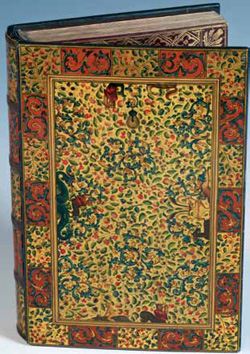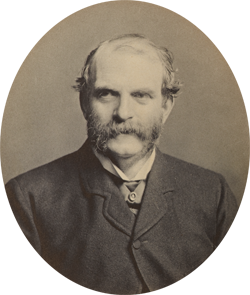A Unique Specimen of the Bibliopegistic Art: Samuel Sandars

John Barbour, The Life and Acts of the Most Victorious Conqueror Robert Bruce, King of Scotland, Edinburgh, 1758, in a nineteenth-century painted wood and varnished binding, described by the bookseller as ‘A unique specimen of the bibliopegistic art’— bibliopegy being the art of binding books. SSS.42.9.
Samuel Sandars’s time as a student at Trinity College in the 1850s and 1860s introduced him to the libraries of Cambridge and fuelled in him a lifelong passion for the antique, the curious and the beautiful. An inheritance from his father in 1879 freed Sandars (1837–1894) to indulge these tastes to the full. Over the ensuing 15 years, guided by his friendships with the librarians Henry Bradshaw and Francis Jenkinson, he bought extensively, bequeathing to the Library a rich collection of books and manuscripts and establishing a Readership in Bibliography in his name.
As a collector his tastes are redolent of the period-lavish illuminated medieval manuscripts, books printed on vellum, and decorative, bejewelled book bindings. Collectors of bindings focused on the book as an object of beauty, curiosity, historical significance or association, rather than for the purposes of reading. Books bound for kings, queens and noblemen or from famous ancient libraries fetched huge prices, encouraging a brisk counter-trade in fakes and forgeries.

Photograph of Samuel Sandars, by Robert Faulkner & Co. of London. Portraits.a.40.











